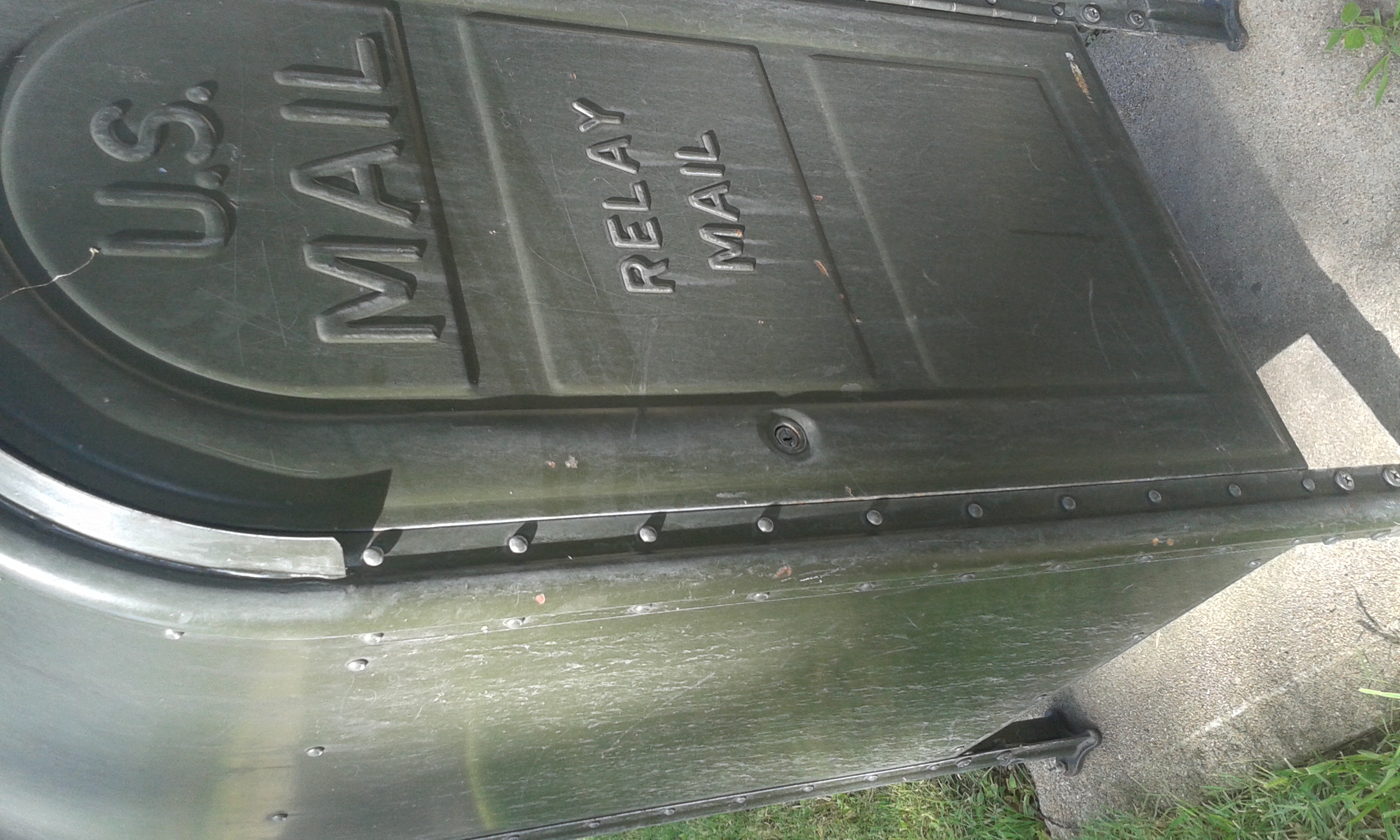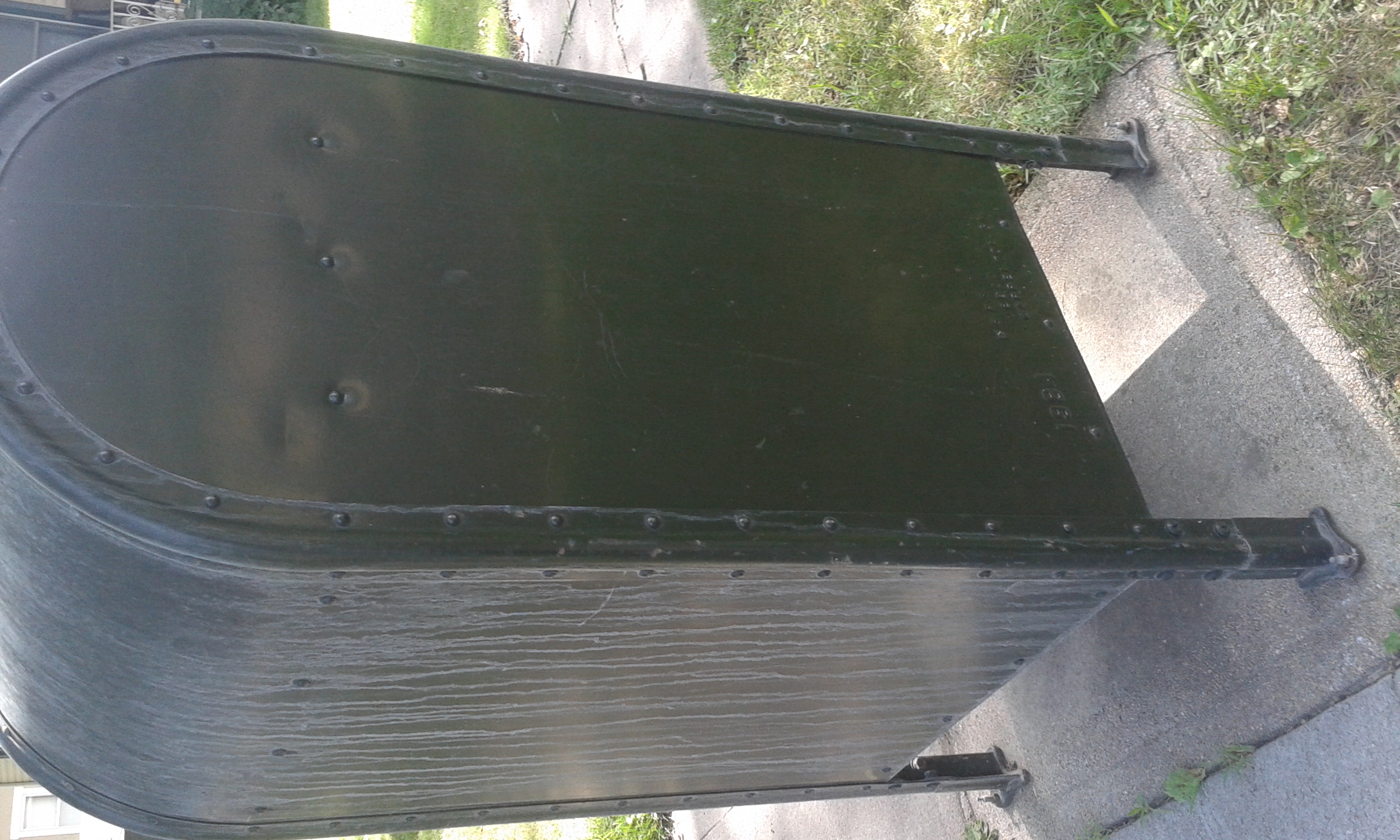It looks like you're using an Ad Blocker.
Please white-list or disable AboveTopSecret.com in your ad-blocking tool.
Thank you.
Some features of ATS will be disabled while you continue to use an ad-blocker.
share:
So, this is an odd one.
I've put off posting this mainly because I figured that I would have found an answer by now, but I haven't.
Down the street from me there is a dark forest green USPS box on the corner. I've walked by it a million times and never really gave it any thought, until about a month ago or so. You see, this box has absolutely NO openings, hinges or keyholes ANYWHERE on it.
I thought that was odd. I mean, what purpose could this thing serve if you can't even open it up anywhere. I did a little online searching looking for answers and all I found were references to them being a drop off box for the mail carriers to leave mail for other carriers. But, all of the ones on the net that they showed had an obvious door on one side or the other. This one down the road has NO openings at all.
So, I thought maybe it was just some type of infrastructure disguised as a post box for aesthetic reasons. So the last time I walked by I checked the entire thing for wires or power sources anywhere on it, and there was nothing to be found. It sits on a concrete pad, bolted down, but with no visible wiring or anything.
Now, I'm not really freaked out or paranoid about it, I just want to be able to wrap my head around the purpose of the damn thing. I hate when I can't understand somethings reasoning.
Does anybody have any clue why there would be a USPS post box with no openings, hinges or keyholes anywhere
ETA- I can probably walk down and get a few pics in a bit if anyone is interested I reckon.
I've put off posting this mainly because I figured that I would have found an answer by now, but I haven't.
Down the street from me there is a dark forest green USPS box on the corner. I've walked by it a million times and never really gave it any thought, until about a month ago or so. You see, this box has absolutely NO openings, hinges or keyholes ANYWHERE on it.
I thought that was odd. I mean, what purpose could this thing serve if you can't even open it up anywhere. I did a little online searching looking for answers and all I found were references to them being a drop off box for the mail carriers to leave mail for other carriers. But, all of the ones on the net that they showed had an obvious door on one side or the other. This one down the road has NO openings at all.
So, I thought maybe it was just some type of infrastructure disguised as a post box for aesthetic reasons. So the last time I walked by I checked the entire thing for wires or power sources anywhere on it, and there was nothing to be found. It sits on a concrete pad, bolted down, but with no visible wiring or anything.
Now, I'm not really freaked out or paranoid about it, I just want to be able to wrap my head around the purpose of the damn thing. I hate when I can't understand somethings reasoning.
Does anybody have any clue why there would be a USPS post box with no openings, hinges or keyholes anywhere
ETA- I can probably walk down and get a few pics in a bit if anyone is interested I reckon.
edit on 21-7-2016 by Chickensalad because: (no
reason given)
Pictures would be helpful. So, a solid box with no scews hold panels together?
about.usps.com...
Street letter boxes have been painted a number of different colors by the Postal Service over the years, but their exact colors for the decades after their introduction in the 1850s is unknown. The earliest known reference to the color of collection boxes is found in The Story of the Post Office (1889), by W.B. Jones, although it is not clear whether the colors applied only to boxes in Boston or to those in other cities as well: There are over 800 street letter boxes from which collections are made by the Boston [post] office and its sub-stations. To people who reside within this postal district it is well known that some of these boxes are painted red and others green. The red boxes are the most important ones, and they are visited every hour by the carriers. Another reference is found in a report of Fourth Assistant Postmaster General J. L. Bristow, dated October 24, 1903, and part of the Congressional Serial Set. The Machen referred to is A. W. Machen, General Superintendent of the Free-Delivery System from May 6, 1893, until May 27, 1903. The color of the paint of the street letter boxes has been changed from time to time according to the taste of the administrative officers of the Department. Years ago it was dark green, afterwards vermilion red . . . In 1897 Machen adopted the aluminum color, and also changed the method of painting . . . posts to be painted green, boxes aluminum bronze. By at least 1909, collection boxes were painted green. On February 27, 1913, however, Postmaster General Frank H. Hitchcock ordered that collection boxes be painted “either vermilion or coach-red.” Ten weeks later, on May 10, the order was rescinded by Postmaster General Albert S. Burleson because fire departments, city councils, and the public complained about the confusion with red fire boxes and equipment. The boxes were repainted green. Green gave way to olive drab after World War I when the War Department gave the Post Office Department a vast supply of surplus olive drab paint. This became the standardized color for collection boxes and remained in use until 1955. On the Fourth of July in 1955, Postmaster General Arthur Summerfield announced that street collection boxes would be painted red, white, and blue to make them easily identifiable. The new paints also were longer lasting. Specifications for the red, white, and blue color scheme were printed in Postal Bulletin 19867, dated August 9, 1955. When the Post Office Department was reorganized, creating the United States Postal Service in 1971, a solid, deep blue color for collection boxes was announced. Reflective decals with the new Postal Service logo were attached to the mailboxes. This color scheme is still used today, with the substitution of the newest Postal Service logo, the “sonic eagle” in white on a blue background, which was adopted in 1993.
about.usps.com...
edit on 21-7-2016 by Onesmartdog because: (no reason given)
Alrighty, I'll head down thataway here in a few and try to get a couple of pics.
It might be a min because I'm suppose to be mowing right now, mwahaaha!
It might be a min because I'm suppose to be mowing right now, mwahaaha!
a reply to: Chickensalad
Seems intriguing ,if I were you I'd try to unbolt it and see what it hides(done discretely obviously),curiosity in this case would more than likely get the best of me here,especially since you said the ones you seen online have an obvious door but this has no openings.
Seems intriguing ,if I were you I'd try to unbolt it and see what it hides(done discretely obviously),curiosity in this case would more than likely get the best of me here,especially since you said the ones you seen online have an obvious door but this has no openings.
edit on 21-7-2016 by VashTheStampede because: (no reason given)
It's likely just a relay box.
mentalfloss.com...
www.google.com... m=isch&q=green+usps+relay+box&imgrc=2m3L_4l1vDEl1M%3A
mentalfloss.com...
www.google.com... m=isch&q=green+usps+relay+box&imgrc=2m3L_4l1vDEl1M%3A
zeus.inf.ucv.cl...
You know a mailbox when you see one. (They’re those blue hunks of metal bolted to the sidewalk with the creaky flaps that go reeeeaaaaaallllk when you pull them open.) But what about the dark-green boxes that don’t have any slots to accept mail?
Called postal relay boxes, these work as storage containers for mail carriers as they make their rounds. Carriers can replenish their bags on the go, removing the need to constantly return to the distribution center (or carry everything at once). They are most prevalent in cities where USPS workers make deliveries on foot, and the boxes are either filled by the carriers themselves or postal workers in trucks who make larger delivery runs.
Ideally, these relay boxes are put at the most convenient possible locations along carriers’ routes. A 1992 study in the American Journal of Mathematical and Management Sciences titled “Locating Postal Relay Boxes Using a Set Covering Algorithm” [PDF] details the number-crunching that goes into this. Using data from Canadian mail routes, the researchers took into account things like maximum mailbag weight (35 pounds), average mail volume (depending on day), and the number of mail carriers who can use each relay box at once. The algorithm resulted in a lower number of needed relay boxes, which cut down on cost.
You may have noticed that a green relay box that was present on your corner, say, ten years ago may no longer be there. As the Internet further reduces the need for paper mail, carrier loads have been getting lighter, accounting for fewer relay boxes. When Gothamist asked a USPS representative about the disappearing boxes, they confirmed that they were being removed “if they were no longer needed.” The rep was also tight-lipped about the very nature of the relay boxes, telling Gothamist’s Jen Carlson, “[They] are for official postal use only. Any further information regarding them is proprietary."
This reticence was likely due to security concerns. According to the Postal Inspection Service’s law enforcement guide, “relay boxes can contain large quantities of mail in gray sacks that thieves cart off looking for checks and credit cards.” It goes without saying, but please leave the relay boxes alone; they're just trying to help.
edit on 22/7/16 by argentus because: added ex tags.
Well, this whole damn thing just got alot weirder for me, and just became a non-story for you guys.
I went down and took two pics, and lo and behold, there's a damn door on it this time. Now, I swear to you there has never been one on there since at least Monday evening. I walk by that damn thing at least 5 times a week, and have looked it over several, several times trying to figure out wtf its purpose was. I came back and told the gf that there was a door on it this time and even she was taken aback a bit.
I promise I would have never even posted this damn thread if it was just a normal box. Nor would I have offered to go take pics just so I can look like an idiot on here.
I'm going to have to go with it being a downgraded T.A.R.D.I.S and the Doctor knew I was intrigued. IDK
I'm just confused as hell right now.


I went down and took two pics, and lo and behold, there's a damn door on it this time. Now, I swear to you there has never been one on there since at least Monday evening. I walk by that damn thing at least 5 times a week, and have looked it over several, several times trying to figure out wtf its purpose was. I came back and told the gf that there was a door on it this time and even she was taken aback a bit.
I promise I would have never even posted this damn thread if it was just a normal box. Nor would I have offered to go take pics just so I can look like an idiot on here.
I'm going to have to go with it being a downgraded T.A.R.D.I.S and the Doctor knew I was intrigued. IDK
I'm just confused as hell right now.


Damn, now this whole damn thing has me questioning my own sanity.
Geez, there was one near my house on the 1950's. It's temporary storage for the postal people and VERY common when the mailman actually walked his
route instead of had a vehicle where he could store stuff. And, as you belatedly discovered, yes, it has a door and a lock and hinges.
Unless it's a conspiracy, of course.
Unless it's a conspiracy, of course.
originally posted by: Chickensalad
Damn, now this whole damn thing has me questioning my own sanity.
Happens to everyone.

originally posted by: Chickensalad
Damn, now this whole damn thing has me questioning my own sanity.
No worries. They Mandela'd you.
Next time you go by, take a closer look at that lock. Does it have any consistent and relative signs of wear?
IDK, maybe they monitor this site, read your post and changed it. Do any of the panels show recent activity? do the rivets look new???
Nah just messing, but being a metal worker, I would notice new work. metal shavings underneath from the men in black installing the door.
concrete dust from new anchors being set???
miscolored concrete under mis aligned foot pads...
Nah just messing, but being a metal worker, I would notice new work. metal shavings underneath from the men in black installing the door.
concrete dust from new anchors being set???
miscolored concrete under mis aligned foot pads...
new topics
-
How To Spot Fake U.F.O. Photos
Aliens and UFOs: 3 hours ago -
Scary video of face in an abandoned house
Paranormal Studies: 5 hours ago -
Just Came Across These Unusual Old UFO Pics
Aliens and UFOs: 7 hours ago -
LA Mayor Bass Demanded $49M in Additional LAFD Cuts One Week Before Wildfires
Mainstream News: 9 hours ago -
Sepultura - Territory - With New Drummer Greyson Nekrutman
Music: 10 hours ago -
Carry On!
Short Stories: 10 hours ago
top topics
-
This should be plastered all over the airwaves
Mainstream News: 16 hours ago, 24 flags -
LA Mayor Bass Demanded $49M in Additional LAFD Cuts One Week Before Wildfires
Mainstream News: 9 hours ago, 17 flags -
Just Came Across These Unusual Old UFO Pics
Aliens and UFOs: 7 hours ago, 7 flags -
Scary video of face in an abandoned house
Paranormal Studies: 5 hours ago, 5 flags -
How To Spot Fake U.F.O. Photos
Aliens and UFOs: 3 hours ago, 4 flags -
Carry On!
Short Stories: 10 hours ago, 3 flags -
Sepultura - Territory - With New Drummer Greyson Nekrutman
Music: 10 hours ago, 2 flags
active topics
-
A Flash of Beauty: Bigfoot Revealed ( documentary )
Cryptozoology • 12 • : TheRickestRick -
Los Angeles brush fires latest: 2 blazes threaten structures, prompt evacuations
Mainstream News • 386 • : Vermilion -
How To Spot Fake U.F.O. Photos
Aliens and UFOs • 2 • : gort69 -
-@TH3WH17ERABB17- -Q- ---TIME TO SHOW THE WORLD--- -Part- --44--
Dissecting Disinformation • 3989 • : WeMustCare -
Old School Punk
Music • 566 • : underpass61 -
To become president, Zelensky had to learn Ukrainian
Political Conspiracies • 44 • : SteamyAmerican -
Judge rules president-elect Donald Trump must be sentenced in 'hush money' trial
US Political Madness • 120 • : Vermilion -
This should be plastered all over the airwaves
Mainstream News • 55 • : Astrocometus -
Oh, Good Gosh. “Kremlin Warns Stay Away from Greenland.”
World War Three • 32 • : SteamyAmerican -
Candidate TRUMP Now Has Crazy Judge JUAN MERCHAN After Him - The Stormy Daniels Hush-Money Case.
Political Conspiracies • 2190 • : WeMustCare
